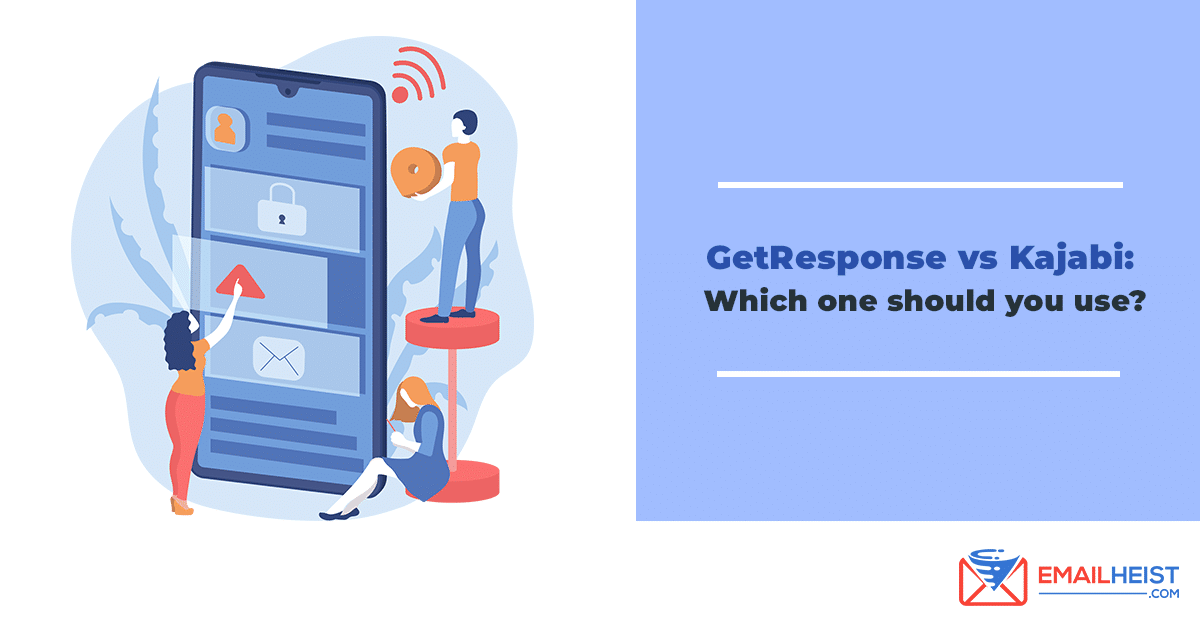GetResponse vs Kajabi: Which one should you choose?
 Kajabi is a digital tool that you can use to build membership sites and courses while GetResponse is an email marketing tool that helps manage your connections with crucial leads through segmented campaigns and attractive messages.
Kajabi is a digital tool that you can use to build membership sites and courses while GetResponse is an email marketing tool that helps manage your connections with crucial leads through segmented campaigns and attractive messages.
In this article, we compare GetResponse vs Kajabi and review the two eCommerce programs to see which is better suited for your needs, whether it be online brand exposure or course-creation and marketing.
Intro to GetResponse
Founded by Simon Grabowski, GetResponse was first launched in 1998 as IMPLIX and relaunched as GetResponse in 2014.
The platform is used by more than 350,000 users – mostly freelancers, small businesses, medium companies and even large enterprises. It is available in 27 different languages. With an employee count of 300, the company operates in Poland, the U.S., Canada, Malaysia, and Russia.
Known to launch and market the very first email autoresponder, GetResponse is widely known throughout the world as one of the greatest marketing and online business platforms there is. With its 20 years of service, it has gained loyalty in 183 countries and support from a handful of esteemed corporations.
Get our FREE course on AFFILIATE MARKETING straight to your inbox
This course includes video tutorials on how to do email marketing.
First functioned as a measly email autoresponder, its compatibility with emailing agents in the 90’s garnered the attention of the general public users of the Interweb. Among these onlookers are successful entrepreneurs that saw GetResponse’s autoresponder automation as an opportunity to further broaden their exposure even from a digital platform.
The success that it has accumulated since then has allowed GetResponse to grow substantially, and the team itself added Online Selling Programs that widened the possibilities for online entrepreneurs. (READ More: Why sign up for GetResponse)
Intro to Kajabi
Founded by Kenny Rueter and Travis Rosser in 2010, Kajabi is mostly used by educators, subject matter experts, influencers, and small businesses.
Kajabi mainly operates in California, United States. Its primary purpose is to allow experts from different fields of professions to set up their very own online classes. Along with these digital platforms, they’ve also integrated email marketing and landing page builder as part of their arsenal of tools.
Ever since its founding, Kajabi is known for its strong capability to offer video streaming for its users. This specific function was granted due to Kajabi’s affiliation with Wistia – one of the well-known versatile video-hosting platforms out there.
Like GetResponse, Kajabi is also labeled as an all-in-one marketing and online selling platform in its respected field due to its similar quantity of capabilities and utilities. Kajabi makes it easier and comprehensive to its potential users and customers. (READ More: Kajabi Features)
Benefits of GetResponse and Kajabi
Now that you know the purpose of each program, we look into the benefits that they offer, analyze if they live up to their purpose, and compare which is more competent.
Deducting the majority of similarities and differences of the two platforms should help us realize which of the two is a better choice to invest in.
Marketing
Let’s start with GetResponse’s marketing ability. Due to its prominence for its top-quality email marketing services, many of its current and former users can testify that its email auto-responding automation is quality and its positive rate of deliverability adds to its credibility.
With its customizable subscriber list, it allows its users to nurture and develop current relationships and loyalties so that their trust can be preserved for a much longer time by carefully segregating each contact base on their actions and intentions to the user.
Accompanied by its professionally-made Landing Page templates that captivate the user’s visitors, its services are indeed beneficial when it comes to online marketing. Users can also use premade workflow automation that helps ease the user’s customer relations, product, and interest segmentation. Furthermore, it makes it possible to conveniently segregate a specific catalog of products based on the visitor’s filtered choices and preferences.
Kajabi’s marketing tools and key strategies on the other hand, also features premade newsletter templates that are also professionally done, adding a sophisticated yet endearing tone to the user’s personal written letters, these newsletters can change depending on its validity and purpose, you can compose your very own event announcement letters, notification letters or even products showcases.
Publishing
Both programs pretty much offer the same amount of publishing services possible except only GetResponse provides its very own Personalized Form-Builder function, which functions as a customizable form builder that lets users modify their forms (sign-up and website forms) based on their liking.
The only difference on GetResponse’s landing page builder is its ability to allow its users to host their pages for free on GetResponse’s subdomain or even in a different domain based on their choice. Kajabi’s landing page creator pretty much has the same initiative, along with its common Drag-and-Drop Builder, that is helpful for many users that are from the earlier generations.
Selling
GetResponse’s Conversion Funnels is there for the purpose of helping you sell your services and products better. These conversion funnels grant its users access to perform online transactions and to personally build and modify their own sales pipeline so that it can be easier for them to track and disintegrate the relevant data from the irrelevant data. GetResponse’s analytics should provide a good analysis and observe the increase and decrease of a user’s sales.
Kajabi’s eCommerce feature was also made possible by the team’s collaboration with its affiliate STRIPE, which allows users to access their electronic transactions within the said Kajabi Domain immediately. Its only downside is its incapability to offer its users to set up their digital stores from its very domain, not unlike GetResponse, which does the exact thing.
Organization
GetResponse and Kajabi both offer CRM that provides significant assistance, especially to those who are in dire need of upholding a stable and healthy relationship with their contacts and leads. The only difference between the two is that GetResponse does not only offer CRM but it also provides data segmentation tools such as A/B Testing for its newsletters and Campaign tracker that conveniently reports all the necessary information such as the actions and interactions that have occurred on the said campaigns, to its respected user.
Kajabi also offers website management to its users. This particular tool is advantageous due to its complex capability to manage your website even from places that are not a part of Kajabi’s domain.
Other Powerful Features
GetResponse
- Webinars
- Third-Party Integration
- API
- Lead Scoring
- Online Behavior Tracking
- Calendars
- ROI Analytics and other forms of Analytics
- Secured Authorization
- Discount Program
Kajabi
- Blog Creation
- Custom Domain
- SEO Optimization
- One-Click Publishing
- Quizzes and Assessment
- Certifications
Pros and Cons of GetResponse and Kajabi
It is a known fact that most of the programs that are specially made by humans are bound to make mistakes; perfection cannot be attained without constant restriction from failure. This very part will focus on the definite Advantages and Disadvantages that possible users may encounter.
These pros and cons will serve as guidelines that intend to purely enlighten the user on certain situations so they might be able to understand the possible solutions and shortcuts that they must do or take.
GetResponse
- Pros
- Easy-to-use tracking tool with Google Analytics integration
- Comprehensive help library
- Award-winning customer support service.
- The diverse list of management tools
- Cons
- No refunds on annual plans upon cancellation.
- Landing pages are not free. However, this isn’t a requirement to sign up for the autoresponder packages.
Kajabi
- Pros
- Highly Integrated Platform
- Great Customer Care
- Has more design templates
- Cons
- Metric system still needs some improvement
- Questionable Email deliverability
- Lack of community forum inside the domain
GetResponse and Kajabi: Pricing Packages
Here are the pricing packages of GetResponse and Kajabi to give you an idea
GetResponse Pricing Plans
- 30-day Free Trial includes:
- email marketing
- 1000 contact
- landing page
- Marketing
Automation - Webinars
- Webforms
and surveys - Advanced analytics
and testing tools - Automated sales, lead and webinar funnels
- $15 per month, this includes:
- Email marketing
- Autoresponders
- Unlimited landing pages
- Unlimited automation templates
- Sales funnels (1 funnel)
- Unlimited lead funnels
- Facebook Ads
- Sell e-products
(READ More: GetResponse Pricing Plans and Packages)
Kajabi Pricing Plans
- 14-day Free Trial includes:
- Easy-to-build digital products
- Customizable website to fit your needs
- Powerful landing page builder
- Beautiful email campaigns
- Built-in analytics
- 24/7 customer support
- $119 per Month (Annual Billing DISCOUNT) includes
- 3 Products
- 3 Pipelines
- Unlimited Landing Pages
- Unlimited Marketing Emails
- 10,000 Contacts
- 1,000 Active Members
- 1 Website
- 1 Admin User
Final Verdict: GetResponse vs Kajabi
Both programs prove they can be beneficial to their users. Choose the one that will suit your needs best. The primary purpose of GetResponse is to maximize the user’s potential eCommerce skills through its built-in marketing and leading automation. Kajabi, on the other hand, is much more suitable to experts who are willing to resort to online platforms just to teach and assess their potential students and use their expertise as their source of livelihood.


